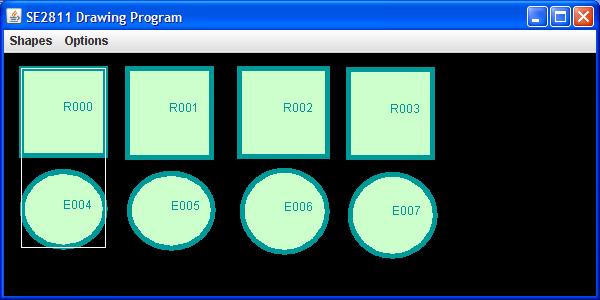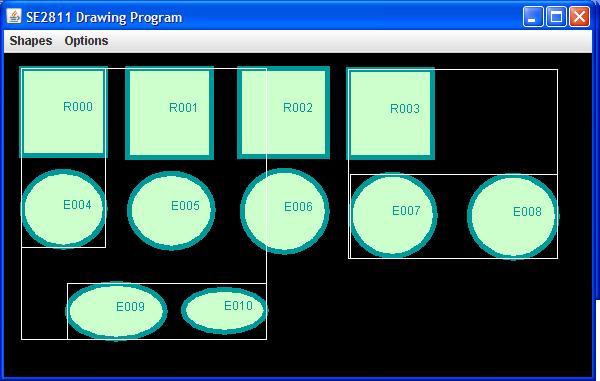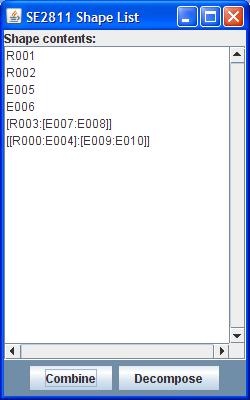This is an old version of this course, from Winter 2014-2015. A newer version is avaliable here.
This and future labs will be teams-of-two labs.
Objective
The objective for this lab is to demonstrate the Composite pattern by grouping shapes in last week's lab.
Outcomes Addressed
Outcomes are the same as last lab.
Overview
Your primary objective in this lab is to allow composites to be treated identically to components. In other words, a Composite should be treated exactly the same as a Shape. You do not necessarily need to implement "transparency" by having a shape implement everything that a composite does -- more on this in the excellent credit section. Do not modify the Rectangle or Ellipse classes in this lab.
To the GUI, we will add a new ShapeListUI GUI. (This makes use of a JList -- do you have experience with this?) The ShapeList. The ShapeManager should communicate with both of the UI windows using the Observer pattern. It should send messages to the observers every time its list of shapes changes.
After adding several shapes, the ShapeList should look something like this:


In the ShapeListUI interface, you should be able to select two or more shapes and combine them into a composite shape via the "Combine" button.
However, the actual combining should be handled in the ShapeManager by a createComposite() method. (Because the ShapeManager changes its list, it should then notify the observers that the shapes have changed, and they should respond by updating their dispays.) This list should remove Shapes from the ShapeManager's list and put them into a composite shape, which is added back to the Shape Manager's list.
The decompose method should undo what createComposite does.
Combined shapes should be drawn with a box around them, and display in the ShapeList as a bracketed, colon-deliminted list. After combining shapes, the ShapeList should look something like this:


As required by the Composite pattern, composites can contain any shape, including other Composites, as shown here:


Assignment
As a starting point, add the CompositeShape and ShapeListUI classes, and implement the Observer pattern to communicate between the ShapeListUI and the DrawingProgramUI.
Next, add the createComposite() and deleteComposite() stubs to ShapeManager and ensure these are correctly tied in to the GUI -- that is, they are called when you click the appropriate buttons.
The Decompose button, as you may suspect, is used to delete the selected CompositeShape(s) (more than one can be selected) while removing constituent Shapes from the composite structure and returning them to their "free-standing" status (When a composite-of-composites is decomposed, the sub-composites should remain intact.). This is a little tricky to implement, as you have to iterate through the CompositeShape you are deleting and re-add its constituent Shapes to the collection that previously contained the composite. Hint: Everything displayed in the ShapeListUI is an element within the top-level collection of Shapes maintained by the ShapeMangager. Whenever a CompositeShape is selected for decomposition, you just have to iterate through CompositeShape to be decomposed, and add each of its children to the top-level collection before and at some point delete the CompositeShape from the top-level collection.
Refer to the in-code javadoc comments for more details concerning how the methods ShapeListUI should function.
Details
Once the basic program is working, implement the Decorator Composite pattern by adding the necessary abstract & concrete classes.
'A' Credit
Ideas for things to go above and beyond:
- As we discussed in class, in the Composite pattern we make a trade-off between transparency and cohesion. Describe how that trade-off influenced your lab. (Use the definition of transparency given by Head First)
- Implement a solution that achieves an elegent blend of transparency and cohesion. Two solutions that won't get credit: Implementing add/remove methods in all shapes and requiring implicit casts by users (i.e., the UI) of the Shape class. You may want to check your solution with me if it seems similar to either of these.
- Describe a few things you tried to keep the ShapeList private while keeping the Observer informed
- Find a solution that keeps the UIs informed without allowing some rookie in the future to edit the shapes from those programs "accidentally"
- Implement the Singleton pattern in such a way that it is impossible for the shapes to access the Shape Manager, but the GUI components can.
Whatever your excellent credit contributions, describe your
Your lab total cannot go over 100.
Submission Instructions
Same general principles for UML class diagrams as the last lab.
Report Format
You will submit this lab in report format with included zip through the web form. (So you will submit a txt, a (UML class) png, and a zip to the webpage.)
Your report should include the following sections:
If you choose to start writing the text early, you may want to include discussion of a "placeholder" UML diagram until your code is stable so you can make the final UML diagram that reflects the final version.
Introduction
Describe the lab in 1 or 2 sentences for someone who hasn't heard of it (but knows last week's). You can assume that I'm your audience for the rest of the report.
Main Application
Describe how you implemented the observer pattern in the main application. Describe any challenges you overcame in implementing the observer pattern to communicate between UI components. Ideally, ShapeManager will not expose its shape list directly to the UI component to reduce coupling. On the other hand, you may want to send the entire ShapeList "state" in the updates. Or "just" send incremental updates.
Use a the UML diagram to illustrate what you describe in this section.
Composite Pattern
Describe how you implemented the composite pattern. Reference a the UML diagram (either from the previous section, or "zoom in" on the relevant classes) and describe how this pattern helped (or hindered) you to organize your code. This may be two to three paragraphs.
Excellent Credit Features
You may leave this section blank (and delete the "Your Feature X Here" subsections) if you decide not to implement any Excellent Credit features.
List your excellent-credit features in a bulleted list, and in subsections as decribed in the subsection following...
Excellent-credit sub-sections
Include a sub-section for each excellent-credit feature or group of related features. The amount of text needed to describe it will vary.Missing Features
Describe any missing requirements in a bulleted list. Any discussion of these is optional.
Please include a statement that there are no missing features if that is the case.
Conclusions
Based on this lab, would you use the Composite pattern again (after this class)? "Yes", "no", "maybe yes", and "maybe no" are equally legitimate, just support your answer. (And make it clear whether you chose maybe yes or maybe no by following proper essay style. Ask me for details.)
Feedback on Lab
Describe what you liked or could have been improved about the lab.
Acknowledgement
This lab developed by MSOE faculty.